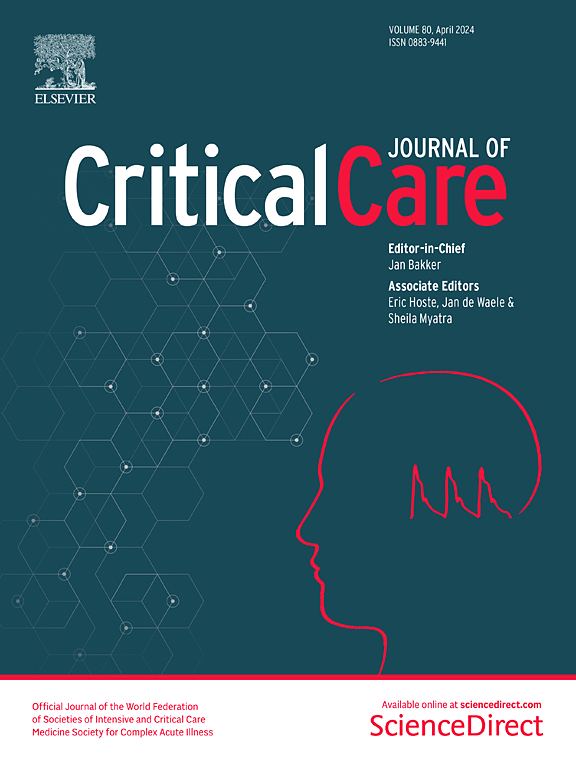Relationship between skin microvascular blood flow and capillary refill time in critically ill patients
IF 8.8
1区 医学
Q1 CRITICAL CARE MEDICINE
引用次数: 0
Abstract
Capillary refill time (CRT) and skin blood flow (SBF) have been reported to be strong predictors of mortality in critically ill patients. However, the relationship between both parameters remains unclear. We conducted a prospective observational study in a tertiary teaching hospital. All patients older than 18 years admitted in the intensive care unit (ICU) with circulatory failure and a measurable CRT were included. We assessed index SBF by laser doppler flowmetry and CRT on the fingertip, at T0 (Within the first 48 h from admission) and T1 (4 to 6 h later). Correlation was computed using Spearman or Pearson’s formula. During a 2-month period, 50 patients were included, 54% were admitted for sepsis. At baseline median CRT was 2.0 [1.1–3.9] seconds and median SBF was 46 [20–184] PU. At baseline SBF strongly correlated with CRT (R2 = 0.89; p < 0.0001, curvilinear relationship), this correlation was maintained whether patients were septic or not (R2 = 0.94; p = 0.0013; R2 = 0.87; p < 0.0001, respectively), and whether they received norepinephrine or not (R2 = 0.97; p = 0.0035; R2 = 0.92; p < 0.0001, respectively). Between T0 and T1, changes in SBF also significantly correlated with changes in CRT (R2 = 0.34; p < 0.0001). SBF was related to tissue perfusion parameters such as arterial lactate level (p = 0.02), whilst no correlation was found with cardiac output. In addition, only survivors significantly improved their SBF between T0 and T1. SBF was a powerful predictor of day-28 mortality as the AUROC at T0 was 85% [95% IC [76–91]] and at T1 90% [95% IC [78–100]]. We have shown that index CRT and SBF were correlated, providing evidence that CRT is a reliable marker of microvascular blood flow. Trial registration Comité de protection des personnes Ouest II N° 2023-A02046-39.求助全文
约1分钟内获得全文
求助全文
来源期刊

Critical Care
医学-危重病医学
CiteScore
20.60
自引率
3.30%
发文量
348
审稿时长
1.5 months
期刊介绍:
Critical Care is an esteemed international medical journal that undergoes a rigorous peer-review process to maintain its high quality standards. Its primary objective is to enhance the healthcare services offered to critically ill patients. To achieve this, the journal focuses on gathering, exchanging, disseminating, and endorsing evidence-based information that is highly relevant to intensivists. By doing so, Critical Care seeks to provide a thorough and inclusive examination of the intensive care field.
 求助内容:
求助内容: 应助结果提醒方式:
应助结果提醒方式:


